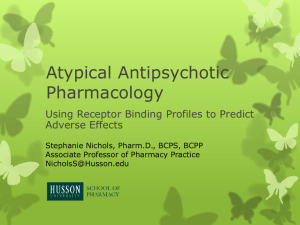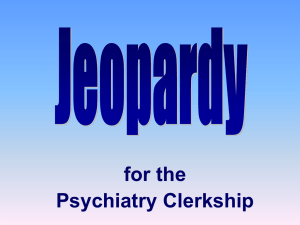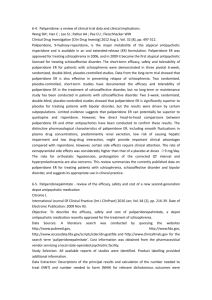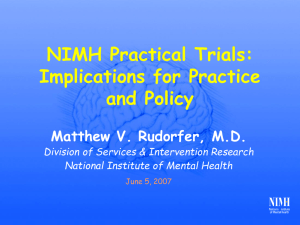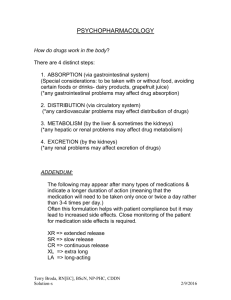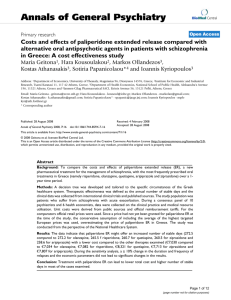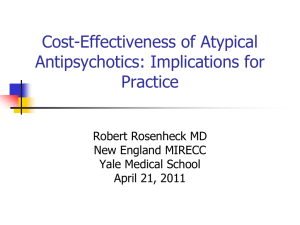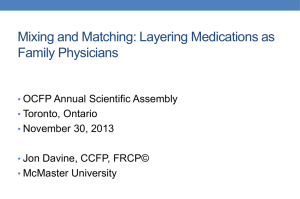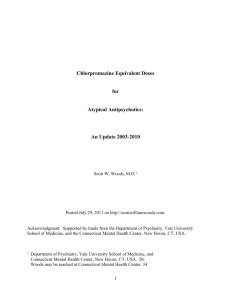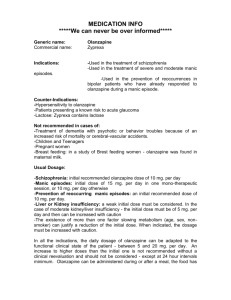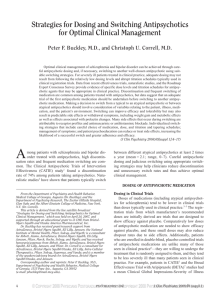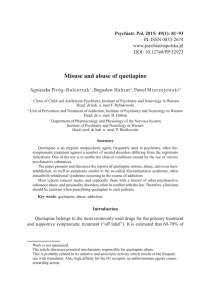(Invega®, Invega Sustenna®), quetiapine
advertisement
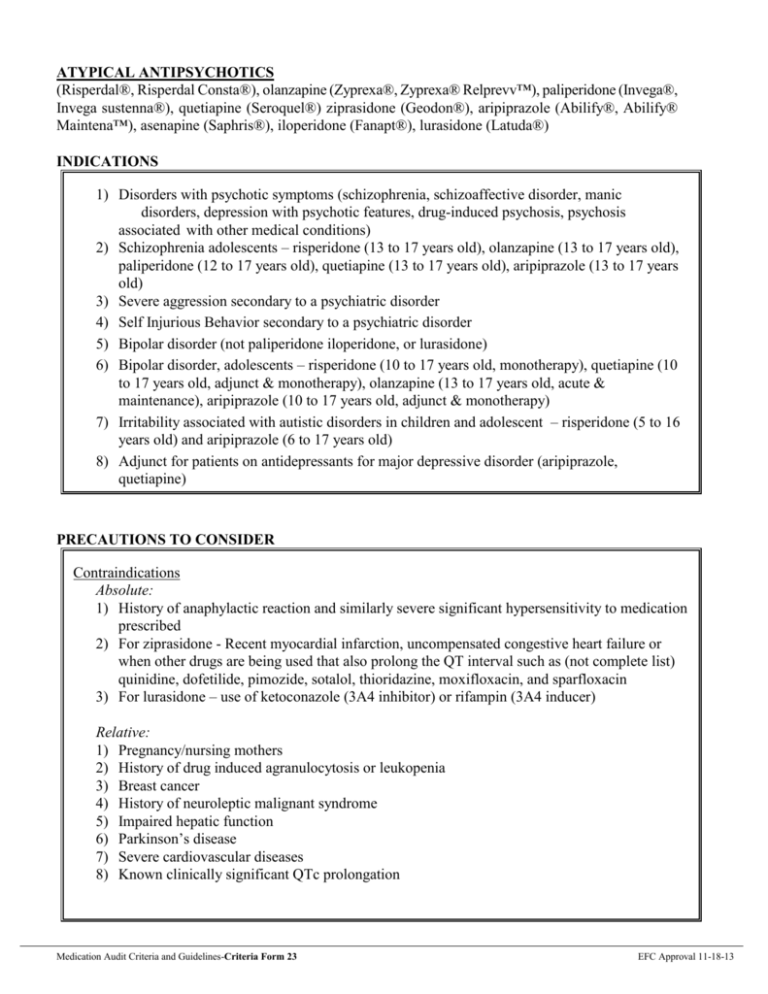
ATYPICAL ANTIPSYCHOTICS (Risperdal®, Risperdal Consta®), olanzapine (Zyprexa®, Zyprexa® Relprevv™), paliperidone (Invega®, Invega sustenna®), quetiapine (Seroquel®) ziprasidone (Geodon®), aripiprazole (Abilify®, Abilify® Maintena™), asenapine (Saphris®), iloperidone (Fanapt®), lurasidone (Latuda®) INDICATIONS 1) Disorders with psychotic symptoms (schizophrenia, schizoaffective disorder, manic disorders, depression with psychotic features, drug-induced psychosis, psychosis associated with other medical conditions) 2) Schizophrenia adolescents – risperidone (13 to 17 years old), olanzapine (13 to 17 years old), paliperidone (12 to 17 years old), quetiapine (13 to 17 years old), aripiprazole (13 to 17 years old) 3) Severe aggression secondary to a psychiatric disorder 4) Self Injurious Behavior secondary to a psychiatric disorder 5) Bipolar disorder (not paliperidone iloperidone, or lurasidone) 6) Bipolar disorder, adolescents – risperidone (10 to 17 years old, monotherapy), quetiapine (10 to 17 years old, adjunct & monotherapy), olanzapine (13 to 17 years old, acute & maintenance), aripiprazole (10 to 17 years old, adjunct & monotherapy) 7) Irritability associated with autistic disorders in children and adolescent – risperidone (5 to 16 years old) and aripiprazole (6 to 17 years old) 8) Adjunct for patients on antidepressants for major depressive disorder (aripiprazole, quetiapine) PRECAUTIONS TO CONSIDER Contraindications Absolute: 1) History of anaphylactic reaction and similarly severe significant hypersensitivity to medication prescribed 2) For ziprasidone - Recent myocardial infarction, uncompensated congestive heart failure or when other drugs are being used that also prolong the QT interval such as (not complete list) quinidine, dofetilide, pimozide, sotalol, thioridazine, moxifloxacin, and sparfloxacin 3) For lurasidone – use of ketoconazole (3A4 inhibitor) or rifampin (3A4 inducer) Relative: 1) Pregnancy/nursing mothers 2) History of drug induced agranulocytosis or leukopenia 3) Breast cancer 4) History of neuroleptic malignant syndrome 5) Impaired hepatic function 6) Parkinson’s disease 7) Severe cardiovascular diseases 8) Known clinically significant QTc prolongation Medication Audit Criteria and Guidelines-Criteria Form 23 EFC Approval 11-18-13 ATYPICAL ANTIPSYCHOTICS (continued) (Risperdal®, Risperdal Consta®), olanzapine (Zyprexa®, Zyprexa® Relprevv™), paliperidone (Invega®, Invega sustenna®), quetiapine (Seroquel®) ziprasidone (Geodon®), aripiprazole (Abilify®, Abilify® Maintena™), asenapine (Saphris®), iloperidone (Fanapt®), lurasidone (Latuda®) PRECAUTIONS TO CONSIDER (continued) Precautions Alcoholism (active), cataracts (quetiapine), recent or current blood dyscrasias, diabetes mellitus, angina, hypotension, congestive heart failure, arrhythmias, obesity, poorly controlled seizure disorder, severe tardive dyskinesia, dementia-related psychosis, renal impairment (paliperidone and ziprasidone injection) Pregnancy and Breast-Feeding See relative contraindications. FDA Pregnancy Category C except for lurasidone is a Category B Drug Interactions of Major Significance 1) Concomitant use of CNS depressants 2) Concomitant use of agents that cause EPS (including droperidol, metoclopramide, amoxapine, metyrosine, pimozide, reserpine) 3) Concomitant use of hypotension producing agents 4) levodopa 5) Antithyroid agents 6) Drugs that prolong the QT interval 7) Strong inhibitors or inducers of Cytochrome 450 8) The following are the major metabolic pathways for the atypical antipsychotics: Risperidone: CYP 2D6 Olanzapine: CYP 1A2 Quetiapine: CYP 3A4 Aripiprazole: CYP 2D6 and 3A4 Ziprasidone; aldehyde oxidase Paliperidone (non-hepatic, primarily renal elimination) Asenapine: CYP 1A2 and UGT1A4 (direct glucuronidation) Iloperidone: CYP 3A4 and 2D6 Lurasidone: CYP 3A4 SEE TABLE A: Cytochrome P450 Drug Metabolism/Inhibition Age-Specific Considerations Aripiprazole, olanzapine, paliperidone, quetiapine and risperidone have approved specific indications for designated ages in children. The safety and efficacy have not been established in children under the age of 18 for the other medications. Conservative dosing is advised in the elderly. Medication Audit Criteria and Guidelines-Criteria Form 23 EFC Approval 11-18-13 ATYPICAL ANTIPSYCHOTICS (continued) (Risperdal®, Risperdal Consta®), olanzapine (Zyprexa®, Zyprexa® Relprevv™), paliperidone (Invega®, Invega sustenna®), quetiapine (Seroquel®) ziprasidone (Geodon®), aripiprazole (Abilify®, Abilify® Maintena™), asenapine (Saphris®), iloperidone (Fanapt®), lurasidone (Latuda®) PRECAUTIONS TO CONSIDER (continued) Side Effects Which Require Medical Attention 1) Anticholinergic effects 2) Visual changes 3) Extrapyramidal side effects (dystonia, pseudo-Parkinsonism) 4) Akathisia 5) Tardive dyskinesia 6) Hypotension 7) Rashes, photosensitivity and altered pigmentation 8) Early symptoms of agranulocytosis (fever, sore throat, weakness) 9) Galactorrhea (risperidone, paliperidone) 10) Amenorrhea (risperidone, paliperidone) 11) Gynecomastia (risperidone, paliperidone) 12) Fluctuating vital signs 13) Altered consciousness 14) Hyperglycemia 15) Clinically significant weight gain 16) Hypercholesterolemia or hyperlipidemia 17) QTc > 500 msec 18) Cataracts (quetiapine) PATIENT MONITORING Patient Monitoring Parameters 1) Pregnancy test – as clinically indicated 2) BMI measurement – when a new antipsychotic is initiated, at every visit (monthly for inpatients) for 6 months after the new antipsychotic is initiated, and quarterly when the antipsychotic dose is stable. 3) Fasting plasma glucose level or hemoglobin A1c – before initiating a new antipsychotic, then yearly. If a patient has significant risk factors for diabetes and for those that are gaining weight – before initiating a new antipsychotic, 4 months after starting an antipsychotic, and then yearly. 4) Lipid screening [total cholesterol, low- and high-density lipoprotein (LDL and HDL) cholesterol, and triglycerides] – Every 2 years or more often if lipid levels are in the normal range, every 6 months if the LDL level is > 130 mg/dl If no lipid screening has been done within the last 2 years, then a lipid profile should be obtained within 30 days of initiation of the drug. Medication Audit Criteria and Guidelines-Criteria Form 23 EFC Approval 11-18-13 ATYPICAL ANTIPSYCHOTICS (continued) (Risperdal®, Risperdal Consta®), olanzapine (Zyprexa®, Zyprexa® Relprevv™), paliperidone (Invega®, Invega sustenna®), quetiapine (Seroquel®) ziprasidone (Geodon®), aripiprazole (Abilify®, Abilify® Maintena™), asenapine (Saphris®), iloperidone (Fanapt®), lurasidone (Latuda®) PATIENT MONITORING (continued) 5) EKG (for patients on ziprasidone)– For patients with known heart disease, a personal history of syncope, a family history of sudden death at an early age (under age 40 years, especially if both parents had sudden death), or congenital long QT syndrome, then a baseline EKG before treatment is initiated. A subsequent EKG is indicated if the patient presents with symptoms associated with a prolonged QT interval (e.g., syncope). 6) EKG (for patients on iloperidone) – at baseline 7) Serum potassium and magnesium level baseline and periodic for patients on iloperidone who are at risk for significant electrolyte disturbances 8) Sexual function inquiry – inquire for evidence of galactorrhea/gynecomastia, menstrual disturbance, libido disturbance or erectile/ejaculatory disturbance yearly If a patient is receiving an antipsychotic known to be associated with prolactin elevation, then at each visit (quarterly for inpatients) for the first 12 months after starting an antipsychotic or until the medication dose is stable and then yearly. 9) Prolactin level – if there is evidence of galactorrhea/gynecomastia, menstrual disturbance, libido disturbance or erectile/ejaculatory yearly. 10) EPS Evaluation (examination for rigidity, tremor, akathisia) – before initiation of any antipsychotic medication, then weekly for the first 2 weeks after initiating treatment with a new antipsychotic or until the dose has been stabilized and weekly for 2 weeks after a dose increase 11) Tardive dyskinesia evaluation – every 3 months and as clinically indicated. 12) Vision questionnaire – ask whether the patient has experienced a change in vision and should specifically ask about distance vision and blurry vision – yearly 13) Ocular evaluations – yearly for patients older than age 40 years; every 2 years for younger patients 14) After each olanzapine pamoate injection continuously observe patient for at least 3 hours for symptoms consistent with olanzapine overdose, including sedation (ranging from mild in severity to coma) and/or delirium (including confusion, disorientation, agitation, anxiety, and other cognitive impairment) (Post-Injection Delirium /Sedation Syndrome) Dosing See DSHS/DADS Drug Formulary for dosage guidelines. Exceptions to maximum dosage must be justified as per medication rule. Medication Audit Criteria and Guidelines-Criteria Form 23 EFC Approval 11-18-13
